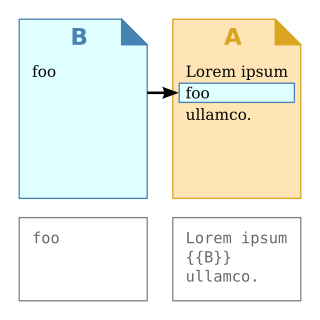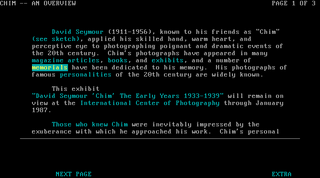
Hypertext is text displayed on a computer display or other electronic devices with references (hyperlinks) to other text that the reader can immediately access. Hypertext documents are interconnected by hyperlinks, which are typically activated by a mouse click, keypress set, or screen touch. Apart from text, the term "hypertext" is also sometimes used to describe tables, images, and other presentational content formats with integrated hyperlinks. Hypertext is one of the key underlying concepts of the World Wide Web, where Web pages are often written in the Hypertext Markup Language (HTML). As implemented on the Web, hypertext enables the easy-to-use publication of information over the Internet.

In computer science, transclusion is the inclusion of part or all of an electronic document into one or more other documents by reference via hypertext. Transclusion is usually performed when the referencing document is displayed, and is normally automatic and transparent to the end user. The result of transclusion is a single integrated document made of parts assembled dynamically from separate sources, possibly stored on different computers in disparate places.

In computing, a hyperlink, or simply a link, is a digital reference to data that the user can follow or be guided to by clicking or tapping. A hyperlink points to a whole document or to a specific element within a document. Hypertext is text with hyperlinks. The text that is linked from is known as anchor text. A software system that is used for viewing and creating hypertext is a hypertext system, and to create a hyperlink is to hyperlink. A user following hyperlinks is said to navigate or browse the hypertext.
This article presents a timeline of hypertext technology, including "hypermedia" and related human–computer interaction projects and developments from 1945 on. The term hypertext is credited to the author and philosopher Ted Nelson.

The Hypertext Editing System, or HES, was an early hypertext research project conducted at Brown University in 1967 by Andries van Dam, Ted Nelson, and several Brown students. It was the first hypertext system available on commercial equipment that novices could use.

The Interactive Encyclopedia System, or TIES, was a hypertext system developed in the University of Maryland Human-Computer Interaction Lab by Ben Shneiderman in 1983. The earliest versions of TIES ran in DOS text mode, using the cursor arrow keys for navigating through information. A later version of HyperTIES for the Sun workstation was developed by Don Hopkins using the NeWS window system, with an authoring tool based on UniPress's Gosling Emacs text editor.
Hypermedia, an extension of the term hypertext, is a nonlinear medium of information that includes graphics, audio, video, plain text and hyperlinks. This designation contrasts with the broader term multimedia, which may include non-interactive linear presentations as well as hypermedia. It is also related to the field of electronic literature. The term was first used in a 1965 article written by Ted Nelson.

"The Mother of All Demos" is a name retroactively applied to a landmark computer demonstration, of developments by the Augmentation Research Center, given at the Association for Computing Machinery / Institute of Electrical and Electronics Engineers (ACM/IEEE)—Computer Society's Fall Joint Computer Conference in San Francisco, by Douglas Engelbart, on December 9, 1968.

Andries "Andy" van Dam is a Dutch-American professor of computer science and former vice-president for research at Brown University in Providence, Rhode Island. Together with Ted Nelson he contributed to the first hypertext system, Hypertext Editing System (HES) in the late 1960s. He co-authored Computer Graphics: Principles and Practice along with J.D. Foley, S.K. Feiner, and John Hughes. He also co-founded the precursor of today's ACM SIGGRAPH conference.
A viewport is a polygon viewing region in computer graphics.
Intermedia was the third notable hypertext project to emerge from Brown University, after HES (1967) and FRESS (1969). Intermedia was started in 1985 by Norman Meyrowitz, who had been associated with earlier hypertext research at Brown. The Intermedia project coincided with the establishment of the Institute for Research in Information and Scholarship (IRIS). Some of the materials that came from Intermedia, authored by Meyrowitz, Nancy Garrett, and Karen Catlin were used in the development of HTML.
Hypervideo, or hyperlinked video, is a displayed video stream that contains embedded, interactive anchors, allowing navigation between video and other hypermedia elements. Hypervideo is similar to hypertext, which allows a reader to click on a word in one document and retrieve information from another document, or another place in the same document. Hypervideo combines video with a non-linear information structure, allowing a user to make choices based on the content of the video and the user's interests.
KMS, an abbreviation of Knowledge Management System, was a commercial second generation hypermedia system, originally created as a successor for the early hypermedia system ZOG. KMS was developed by Don McCracken and Rob Akscyn of Knowledge Systems, a 1981 spinoff from the Computer Science Department of Carnegie Mellon University.
DynaText is an SGML publishing tool. It was introduced in 1990, and was the first system to handle arbitrarily large SGML documents, and to render them according to multiple style-sheets that could be switched at will.
Computer graphics are graphics created by computers and, more generally, the representation and manipulation of pictorial data by a computer.

Hypertext is text displayed on a computer or other electronic device with references (hyperlinks) to other text that the reader can immediately access, usually by a mouse click or keypress sequence. Early conceptions of hypertext defined it as text that could be connected by a linking system to a range of other documents that were stored outside that text. In 1934 Belgian bibliographer, Paul Otlet, developed a blueprint for links that telescoped out from hypertext electrically to allow readers to access documents, books, photographs, and so on, stored anywhere in the world.
John F. "Spike" Hughes is a Professor of Computer Science at Brown University.

Computer Graphics: Principles and Practice is a textbook written by James D. Foley, Andries van Dam, Steven K. Feiner, John Hughes, Morgan McGuire, David F. Sklar, and Kurt Akeley and published by Addison–Wesley. First published in 1982 as Fundamentals of Interactive Computer Graphics, it is widely considered a classic standard reference book on the topic of computer graphics. It is sometimes known as the bible of computer graphics.

The File Retrieval and Editing SyStem, or FRESS, was a hypertext system developed at Brown University starting in 1968 by Andries van Dam and his students, including Bob Wallace. It was the first hypertext system to run on readily available commercial hardware and OS. It is also possibly the first computer-based system to have had an "undo" feature for quickly correcting small editing or navigational mistakes.

Video random-access memory (VRAM) is dedicated computer memory used to store the pixels and other graphics data as a framebuffer to be rendered on a computer monitor. This is often different technology than other computer memory, to facilitate being read rapidly to draw the image.










